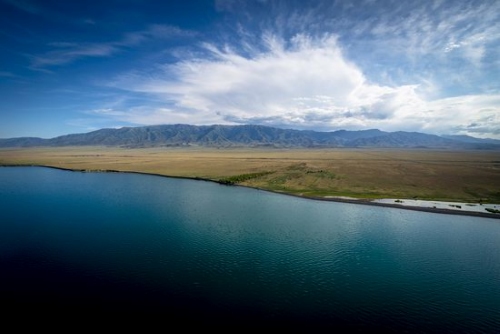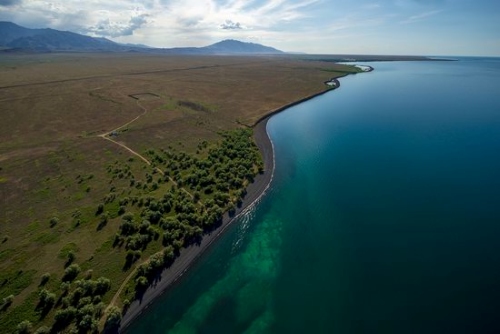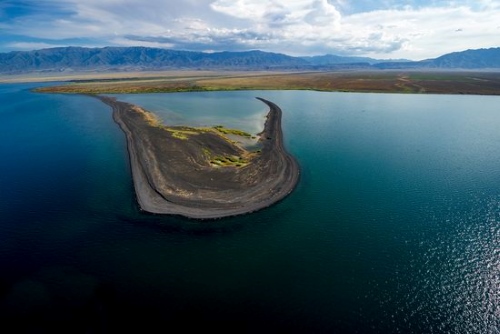Kazakhstan, which has natural wonders, is renowned for its vast steppes/grassland and undeveloped mountain ranges. However, Lake Alakol, which is one of the most natural and colourful lakes in the world, frequently goes unnoticed and is a mysterious salt lake hidden in the east of the nation, close to the Chinese border. At first glance, it seems like just another body of water in a dry, windblown land—but spend a little time by its shores, and it becomes clear that Alakol is anything but ordinary.
This lake has layers. Not just of water and salt, but of stories, of colour, and of science that still hasn’t quite caught up with local belief.
Which Is The Most Colourful Lake In The World?
As per Earth.com, Lake Alakol is known as the most colourful lake in the world.

Source: aboutkazakhstan
What are the features of Lake Alakol?
Features of Lake Alakol are given in the table below:
| Aspect | Details |
| Location | Eastern Kazakhstan, near the Chinese border |
| Type | Endorheic salt lake (closed basin) |
| Surface Area | Approximately 1,000 square miles (variable by season) |
| Salinity | About 50% of the Atlantic Ocean’s salinity |
| Therapeutic Claims | Eczema relief, joint pain reduction, and skin rejuvenation |
| Tourism Hub | Koktuma town – guesthouses, hot saunas, local markets |
| Birdlife | Dalmatian pelicans, flamingos, and relict gulls |
| UNESCO Designation | Part of the Man and the Biosphere Programme since 2013 |
| Environmental Status | Ramsar-recognised wetland and key Central Asian flyway for migratory birds |
Lake Alakol: A Strange Beauty

Source: aboutkazakhstan
Unlike typical freshwater lakes, Lake Alakol is saline, meaning its water is rich in minerals and salt. That might sound off-putting, but locals swear by its healing qualities. Many people in the region believe a dip in the lake helps with skin conditions, joint pain, and even respiratory issues. And it’s not just an old wives’ tale—people travel hundreds of kilometres every summer just to soak in its slightly oily, mineral-rich water.
Of course, scientists are more cautious. There's no definitive research confirming the lake cures ailments, but the high mineral content, combined with the dry climate and clean air, makes it a kind of natural spa—whether the effect is physical or just wonderfully psychosomatic.
Which is the only lake in the world that changes its colour?
.jpg)
Source: esa.int
One of the most fascinating things about Lake Alakol is how its colours shift throughout the year. In early spring, when the ice has just melted, it might look icy blue or grey. Come midsummer, depending on how the sunlight hits it, the lake can turn a deep green, rusty red, or even shimmering silver. Locals often say that the lake mirrors the sky’s mood. It’s a poetic way of describing something scientists now track with satellite images.
These colours are largely due to the lake’s unique algae, sediment, and mineral patterns, which change as water levels rise and fall. Since Alakol doesn’t drain into any other body of water, all the minerals that flow in just stay there. Over time, this creates a delicate ecological cocktail that even small changes in temperature or rainfall can disrupt.
A Haven for Birds and Biodiversity
But it’s not just humans who find comfort at Alakol. Every year, migratory birds stop at the lake to rest, feed, and breed. Some of them—like the Dalmatian pelican or the elegant relict gull—are either rare or endangered. They flock to small islands in the middle of the lake, where predators can’t easily reach their nests. One island in particular, Ul’kun-Aral-Tyube, has become a vital sanctuary, and conservation efforts are underway to protect it.
Birdwatchers from all over Central Asia come here during the nesting season. Early mornings on the lake are filled with the sound of wings flapping and birds calling—a surprisingly vibrant scene in what might otherwise seem like an isolated, desolate place.
What is the history of Lake Alakol and its healing in nature?

Source: aboutkazakhstan
Centuries ago, Alakol was a waypoint for Silk Road traders. Its waters, likely as salty then as now, offered weary merchants a place to stop and recover. Some say the name “Alakol” even comes from Turkic words meaning “motley lake” or “many-coloured lake”.
Today, instead of caravans, tourists arrive by train, especially from Almaty, looking for a few days of peace. The village of Koktuma—more of a resort hamlet now—has a scattering of guesthouses, saunas, and even some modest cafés. It’s not overdeveloped (yet), but every year brings more visitors, and with them, more pressure on the lake’s fragile ecosystem.
A Climate Warning and a Call for Balance
As seen with climate change due to global warming and other human interventions, climate models indicate that rising temperatures and decreased snowpack from the nearby Dzungarian Alatau Mountains could significantly reduce the lake’s water inflow. Less freshwater means more salt — a threat to both wildlife and the lake’s healing charm.
Lake Alakol is a system in balance. Change one part — less snow, more tourists, fewer birds — and the entire rhythm could fall out of tune.
Conclusion: Protecting a Natural Treasure
Lake Alakol isn’t just a body of water. It’s a living landscape of colour, healing, sound, and story. It reflects both nature’s resilience and fragility. Standing at its edge at dusk, feeling the breeze and hearing the cries of birds overhead, one thing becomes clear — this is a place where silence, salt, and time hold their kind of power.
Preserving that magic isn't just a regional duty — it’s a global responsibility.
Comments
All Comments (0)
Join the conversation